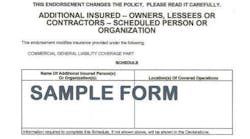By KENNETH M. ELOVITZ, P.E., Esq., Energy Economics, Inc., Newton Centre, MA
Clients sometimes ask engineers to make the client an additional insured on the engineer's general liability (GL) insurance policy. GL insurance covers claims:
that the insured becomes legally obligated to pay as damages because of "bodily injury'" or "property damage" to which this insurance applies.1
The bodily injury or property damage must be the result of an "occurrence", which usually means a sudden and accidental or unintended event or action.
A basic policy covers only acts of the named insured (the person or entity listed in the declaration and usually who pays the premium). It is often possible to extend coverage to other identified persons or entities as additional insureds, sometimes at little or no cost. Additional insureds have the same coverage as the named insured. Therefore, it starts to look like being an additional insured on someone else's policy is a way to get insurance for free.
Additional insured status is intended to provide coverage if someone makes a claim against the additional insured as a result of the named insured's negligence. For example, a general contractor has overall responsibility for a construction site but could have vicarious liability for a subcontractor's negligence. As an additional insured on the subcontractor's GL policy, the general contractor would get coverage for that incident under the subcontractor's policy.
Engineers' professional liability coverage is completely inapplicable to clients who do not provide engineering services.Additional insured status is largely a matter of administrative convenience for the additional insured (the general contractor in the example): Whether the general contractor is an additional insured or not, the subcontractor remains liable to the general contractor for the subcontractor's negligence. If the general contractor is not an additional insured under the subcontractor's policy, the general contractor would simply report the claim to its GL insurance carrier who would sue the subcontractor. The subcontractor would tender the general contractor's claim to its (the sub's) insurance carrier.
But a general contractor with additional insured status can make a claim directly against the subcontractor's insurance company instead of making its claim against the subcontractor. The general contractor would still be well advised to notify its own GL carrier to protect itself.
Whether the general contractor is an additional insured or the general contractor notifies its insurance company, who subrogrates against the subcontractor, the subcontractor's insurance company defends the claim. Therefore, the difference is more of form than substance. Of course, there are limits and exceptions.
Limits and Exceptions
(1) Additional insured status is never available under an engineer's professional liability policy. Engineers' professional liability coverage is completely inapplicable to clients who do not provide engineering services. A client who is not a design professional does not have design liability that arises out of the engineer's professional services. And while an architect could have vicarious or "captain of the ship" liability for its subconsultant engineer's error or omission, the practice of the industry is not to grant additional insured status even for fellow design professionals;
(2) General liability (GL) policies almost always exclude coverage for professional services. Coverage does not extend to contract provisions:
Under which the insured, if an architect, engineer or surveyor, assumes liability for an injury or damage arising out of the insured's rendering or failure to render professional services, including ... supervisory, inspection, architectural or engineering activities.2
With some variation based on policy language and state law, "arising out of" is construed broadly to enforce the exclusion. In Travelers Indem. Co. v. Figg Bridge Engineers, Inc., the claims alleged failure to warn of a danger and negligent misrepresentation about a danger.3 The engineer's GL insurer argued it had no duty to defend because the underlying claims "arose out of" the engineer's professional services. The engineer argued GL coverage should apply because the claimed failings do not constitute professional services, so fall outside the exclusion and bring the claim into the policy coverage.
The court agreed with the engineer that there is a "distinction between what [the engineer] is alleged to have done versus what [the engineer] contracted to do."4 An allegation of negligence that is not a professional service could be enough to avoid the professional services exclusion and invoke a defense under the policy even if what the engineer agreed to do by contract constituted professional services.
However, the court also found that "arising out of" requires only some causal connection or relationship between the claimed negligence and the contracted scope of services.5 Allegations that the engineer failed to warn its employees and other workers of the dangers of working on a bridge under construction had a sufficient connection to the professional services provided under the contract to bring them within the professional services exclusion and to defeat coverage for the additional insured.
(3) Additional insured status is intended to protect the additional insured only against liability it faces because of the named insured's actions. At one time, additional insured endorsements used broad language that courts interpreted to cover the additional insured even for the additional insured's sole negligence. In effect, therefore, being an additional insured was a way to get free insurance.
But insurance companies did not like paying claims they did not anticipate for entities not their customers. They responded by revising the additional insured endorsement to cover the additional insured:
only with respect to liability for "bodily injury", "property damage" or "personal and advertising injury" caused, in whole or in part, by:
a. [The named insured's] acts or omissions; or
b. The acts or omissions of those acting on [the named insured's] behalf; in the performance of [the named insured's] ongoing operations for the additional insured.6
Courts have enforced policy provisions that deny additional insured coverage for the additional insured's sole negligence.
Indeed, companies commonly issue additional insured endorsements that specifically limit coverage to situations where liability arises out of the named insured's negligence. See, e.g., Harbor Ins. Co. v. Lewis, 562 F. Supp. 800, 801 (E.D. Pa. 1983) (additional insureds covered "only to the extent of liability resulting from occurrences arising out of negligence" of the named insured); Consolidation Coal Co., 406 F. Supp. at 1294 (additional insured covered "only with respect to acts or omissions of the named insured"); Maryland Cas. Co. v. Nationwide Ins. Co., 65 Cal. App. 4th 21, 28 (1998) (additional insured covered "only to the extent [the additional insured] is held liable for [the named insured's] acts or omissions arising out of and in the course of operations".)7
(4) Additional insured status is only available to a:
person or organization for whom [the named insured is] performing operations when [the named insured] and such person or organization have agreed in writing in a contract or agreement that such person or organization be added as an additional insured on [the named insured's] policy.8
Issuing a certificate of insurance identifying the client as an additional insured does not create additional insured status, even when the engineer's GL policy includes a blanket additional insured endorsement. The standard blanket endorsement says the requirement to be an additional insured must be part of a written agreement, put in place before the start of the engagement, for the client to obtain additional insured status.
Trying to add an additional insured by certificate of insurance after the contract is in place might encourage an enterprising lawyer for a disappointed client to sue the engineer for breach of contract or misrepresentation about whether the engineer met the administrative requirements of the contract. Even if such a claim has no merit, the engineer would have to defend it. And this would also be at the engineer's own cost because liability insurance, PL or GL, covers negligence, not breach of contract.
Detriment to the Named Insured
(1) The policy limits are split among the main insured and all additional insureds. An additional insured might not have much coverage in a case where there are a lot of potential defendants or a claim has already been paid under the named insured's policy;
(2) Additional insured status invites a fight between the additional insured's General Liability carrier and the named insured's carrier about which coverage is primary. Depending on the circumstances, the two companies might wind up splitting the cost. If the client made a claim against the named insured (no additional insured status), each policy would cover its own insured;
(3) Additional insured coverage is intended to apply only when the additional insured could otherwise bring a claim against the named insured. In that case, the interests of the additional insured are adverse to the interest of the named insured. A named insured might not want to share insurance coverage and defense decisions with someone who is making a claim against it. The named insured might prefer to have the client not be an additional insured and make the claim against the named insured. Then the name insured's insurance company can defend the named insured alone.
The potential conflict of interest between the additional and named insured might require separate counsel for each party.
The potential conflict of interest between the additional and named insured might require separate counsel for each party. Economizing on defense costs is one of the justifications for granting additional insured status. If the adversity between the additional insured and the named insured requires separate counsel for each, the anticipated savings in attorney fees might not materialize.
(4) "We require it of all our contractors," the client might announce. Whether that statement is true or not, engineers are not "contractors". In the construction industry, "contractor" is a term of art. "Contractors" perform the work of the project. Engineers, along with architects and other specialty consultants, provide services. It is important to maintain that clear distinction to avoid confusion over which entity is responsible for which aspects of the project.
Contractors have different risks and exposures from engineers. Contractors maintain operations on the site and have control of the site. Unless they maintain a construction trailer or have an office at the site, engineers do not have operations at the site that could injure third parties. Therefore, engineers rarely have exposures at the site that the engineer's GL policy would cover, either for the engineer or for the client as additional insured. Unlike contractors, almost all the engineer's activities at a job site fall under the professional services exclusion.
(5) Additional insured status can backfire resulting in no coverage for either the additional insured or the named insured. Or the named insured might have to sue the insurance company to obtain coverage under the policy. That happened in the case of Patrick Engineering, Inc. v. Old Republic Gen. Ins. Co.9
In Patrick, an electric utility retained an engineering firm for design services in connection with a project to relocate utility poles. While working on the project, the utility smashed through some underground sewer lines. The town that owned the sewer lines sued the utility saying the utility was negligent.
The engineer's contract with the utility required the engineer to name the utility as an additional insured on the engineer's general liability insurance policy, which it did. When the town sued the utility, the utility sought coverage as an additional insured under the engineer's general liability policy. But the engineer's insurance company denied coverage, citing the professional services exclusion and pointing out that the utility's liability (if any) did not arise out of the engineer's negligence. Unhappy with that result, the utility then sued the engineer for breach of contract for failing to provide contractually required insurance.
Since Professional Liability insurance does not cover breach of contract claims, the engineer had to defend itself against that claim at its own expense. The engineer also sued its GL carrier (again at its own expense) seeking coverage under that policy for the utility's damage to the underground sewer (a problem the engineer did not create).
The engineer's additional insured endorsement used the old "arising out of" language to define the extent of additional insured coverage.
Therefore, the court found that any causal connection between the engineer's services and the liability was enough to grant the utility additional insured status under the engineer's GL policy. The court used the policy provision for separation of insureds to apply the professional services exclusion to the engineer but not to the additional insured (utility) for its non-professional negligence. While the engineer ultimately obtained coverage for the utility as an additional insured, under the current, more restrictive definition of who is an insured, the result might be different.
Although the engineer won the battle, it was at considerable expense and with potential long-term consequences for its insurance experience rating. If the utility had not been an additional insured, the only real difference would have been that the utility and its insurance company would have been responsible for the utility's negligent act. The town would still have been made whole, and the engineer would have avoided a lot of attorneys' fees.
The Patrick case is an example of a named insured providing coverage for an exposure it had not intended to cover. Insurance companies have attempted to solve that problem with changes to policy language that requires some negligence by the named insured to extend coverage to the additional insured.
Closing thoughts
Individuals and firms buy insurance to protect themselves against the financial consequences of unfortunate events. Clients have an interest in seeing that their consultants have insurance so a catastrophic event does not put the consultant out of business and prevent the consultant from fulfilling its contract with the client. The idea that insurance is for the benefit of the client (or other potential claimant) hijacks the fundamental concept of insurance.
Being an additional insured is not a substitute for buying insurance.
Being an additional insured is not a substitute for buying insurance. Depending on how the policy and the additional insured endorsement are written, the additional insured does not get coverage for the additional insured's own negligence.
Additional insured status is not intended to be "free" insurance nor a pot of money that clients can use for cost recovery. Language in current additional insured endorsements is designed to require some negligence by the named insured to extend coverage to an additional insured. Therefore, clients who think additional insured status can "protect" their own insurance coverage or insurance experience rating are misinformed. Clients should not expect to get insurance from their engineers, "free" or otherwise. After all, engineers provide engineering services, not insurance services.
In the context of engineers providing engineering services, additional insured status under an engineer's GL policy is unlikely to help the client. Whether for defense strategy reasons, dilution of coverage, or, as the engineer in Patrick found out, making a client an additional insured can actually hurt the engineer. It is time for the practice to stop.
##########
1 ISO Commercial General Liability Form CG 00 01 04 13, Section I, Coverage A 1.a;
2 ISO Commercial General Liability Form CG 00 01 04 13, Section I Coverage A Exclusions 2.b.(2) and Section V, Definitions, 9. f.(3);
3 389 F.Supp.3d 1060 (S.D. Fla. 2019);
4 Figg at page 1070;
5Figg at page 1071;
6 ISO Form CG 20 33 04 13 ADDITIONAL INSURED – OWNERS, LESSEES OR CONTRACTORS – AUTOMATIC STATUS WHEN REQUIRED IN CONSTRUCTION AGREEMENT WITH YOU;
7 NES Equipment Services Corporation, d/b/a NES Rentals v. Acadia Insurance Company and Firemen's Insurance Company of Washington, D.C., Middlesex (Massachusetts) Superior Court, Civil Action No. 14-CV-1064-H, September 28, 2016;
8 Ibid;
9 2012 IL App (2d) 111,111, 973 N.E.2d 1036, 362 Ill.Dec. 640 (Ill. App. 2012).
##########
A member of HPAC Engineering’s editorial advisory board, the author is both a mechanical and electrical engineer, as well as in-house counsel for Energy Economics, Inc., a consulting engineering firm based near Boston MA. He can be reached at [email protected].









